Prisons
Santa in the Slammer

Posted By: Paul - Tue Dec 12, 2023 -
Comments (1)
Category: Holidays, Prisons, 1970s
She sold her body for gingerbread
Requesting "all the ginger-bread she could eat" in exchange for her body after death initially struck me as a bizarre detail. But the more I think about it, the more reasonable it seems given that condemned prisoners often request cookies, candy, junk food, etc. as their last meal.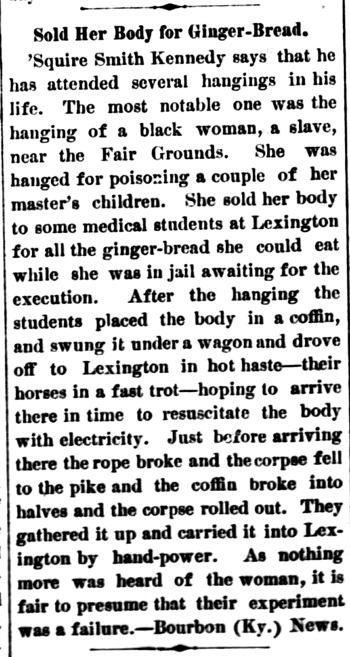
Whiting Weekly News - Jan 25, 1890
Posted By: Alex - Sat Nov 18, 2023 -
Comments (1)
Category: Death, Food, Prisons, Experiments, Nineteenth Century
Miss KGB and Miss Gulag
Some oddball beauty titles from Russia.In 1990, 23-year-old Katya Mayorova was crowned 'Miss KGB'. It was part of an effort to put a softer face on the intelligence service. It doesn't seem that there was a competition to select the winner. Mayorova was simply selected by a secret process. As far as I know, she was the only one to ever hold the title.

The Montreal Gazette - Nov 4, 1990
click to enlarge


You can find more info about Miss KGB at Russia Beyond.
And from a totally different part of the Russian security apparatus, many women's prisons in Russia now hold beauty pageants. The winners aren't called 'Miss Gulag,' but that was the title of a documentary about the pageants. More info from Jean Trounstine, "Beauty Pageants in Prison Can Have Positive Effects," in At Issue: Beauty Pageants (2010).
As a woman who grew up in the sixties, I used to consider endorsing any sort of beauty contest inconceivable—but that was before I saw two short documentaries about the pageants at Camp UF-91/9, The Contest, produced by the Polish journalist Zygmunt Dzieciolowski, and Miss Gulag, produced by Neihausen-Yatskova and Vodar Films. They show the contenders taking the runway by storm, cheered on by their peers, in a parody of the stale rigidity and lack of sexuality of traditional pageants. . .
Beauty pageants are now widespread in Russian prisons. Make up, gifts for the unit, and credits toward early release are the prizes.
The Contest documentary: part 1, part 2, part 3
Posted By: Alex - Wed Aug 10, 2022 -
Comments (1)
Category: Awards, Prizes, Competitions and Contests, Prisons, Spies and Intelligence Services, Russia
The Prison Bra Rule
In 1975, Scharlette Holdman, executive director of Hawaii's ACLU, tried to visit a prisoner in an all-male Hawaiian prison, at the prisoner's request. While being searched it was discovered that she wasn't wearing a bra, and so she was denied entry. She sued, and the case went to the Hawaiian Supreme Court which ruled in favor of the prison. As a result, it remains the rule that all female visitors to Hawaiian prisons must wear bras, whether or not the lack of a bra is evident.The case: Holdman v. Olim (1978)
More info from Dressing Constitutionally by Ruthann Robson:

Honolulu Advertiser - Feb 3, 1975
Posted By: Alex - Sat Jun 11, 2022 -
Comments (2)
Category: Prisons, Underwear, 1970s
Frank P. Reese, light-bulb eater
When they say that the food in prison is awful, I guess that depends on what you like to eat.
Detroit Free Press - Mar 26, 1972

El Paso Times - Mar 25, 1972
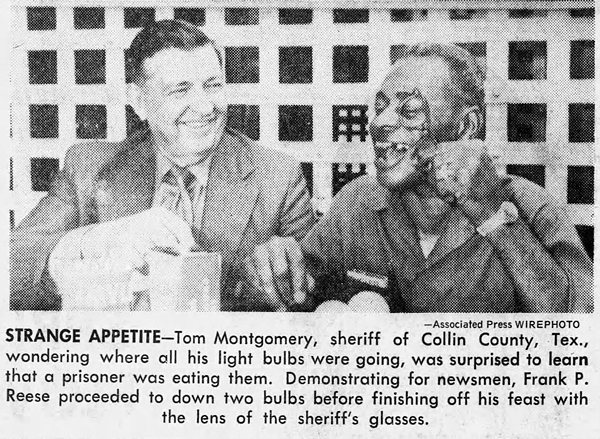
Binghamton Press and Sun-Bulletin - Mar 25, 1972
Posted By: Alex - Sun Mar 06, 2022 -
Comments (2)
Category: Food, Prisons, 1970s
Inmate seeks transfer
Specifically, he wanted to be transferred to a woman's prison so that he could "be fruitful and multiply and replenish the earth."He must have figured it didn't hurt to ask.

Miami News - Nov 10, 1971
Posted By: Alex - Sat Nov 06, 2021 -
Comments (0)
Category: Prisons, Gender, 1970s
Death by playing cards
Oct 20, 1930: Convict William Kogut, who was waiting execution on San Quentin's death row, somehow knew that it was possible to make a bomb out of playing cards. This was because, at the time, the red ink of cards contained nitrocellulose. So by scraping off enough of the red ink, Kogut was able to make a pipe bomb out of a hollow bedpost. He used this to kill himself, rather than letting himself be executed.Modern playing cards no longer contain this explosive ingredient.
Somewhat confusingly, Snopes classifies his death as a "legend," even though their brief write-up seems to confirm that it happened exactly as described.
More info: theatrefx.com
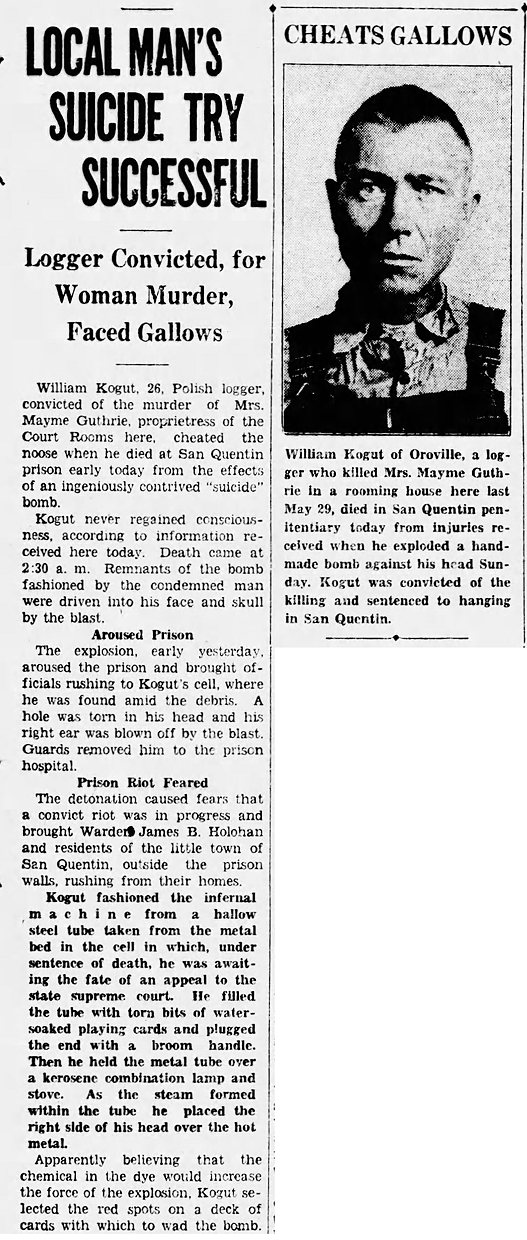
Oroville Mercury Register - Oct 20, 1930
Posted By: Alex - Wed Jun 23, 2021 -
Comments (3)
Category: Death, Suicide, Prisons, 1930s
Cockroach trained to carry cigarettes
1938: Prisoners in solitary confinement in Amarillo, Texas figured out how to get cigarettes by training a cockroach to carry them under the cell door.
Salt Lake Tribune - Mar 2, 1938
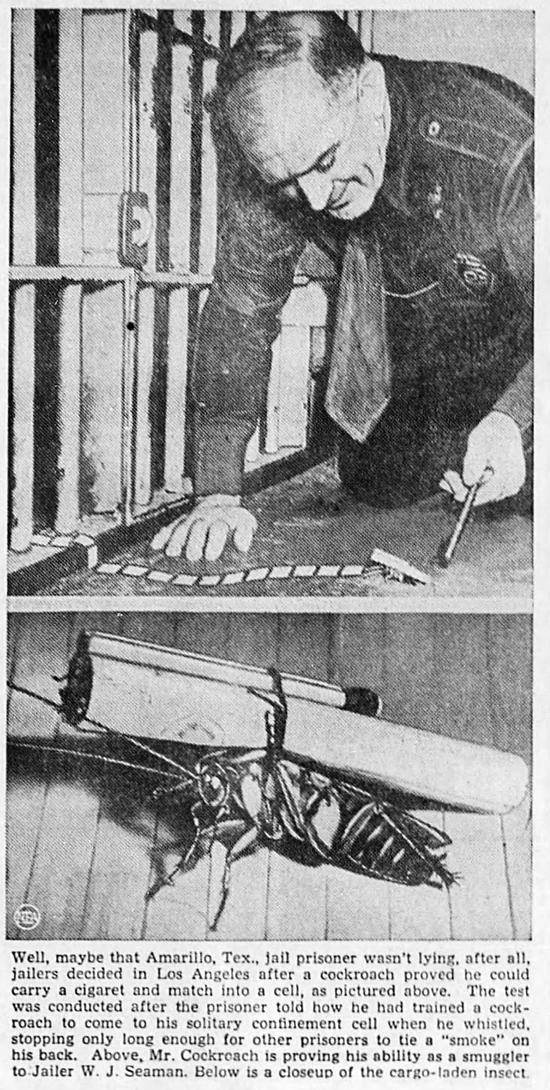
Klamath News - Apr 9, 1938
Posted By: Alex - Mon Aug 17, 2020 -
Comments (1)
Category: Prisons, Smoking and Tobacco, 1930s
Prisoners who escape a day before release
The recurring weird news theme of prisoners who escape from jail a day before they're set to be released. Usually the escape isn't anything too complicated. They're on a minimum-security work detail, from which they simply walk away. But still, why leave if all you have to do is wait a day and be legally free? Because if caught again, they're looking at years of new imprisonment.Three examples below, though I'm sure there must be more. Worth noting: I didn't find any follow-up stories mentioning their capture. So maybe they all got away with that one extra day of freedom.

McComb Enterprise-Journal - Mar 11, 1990

- Sentinel News - Dec 13, 2013

-Newport Buzz - Mar 1, 2016
Posted By: Alex - Mon Jan 08, 2018 -
Comments (2)
Category: Prisons
Mongolian Box Prison

Source of photo.
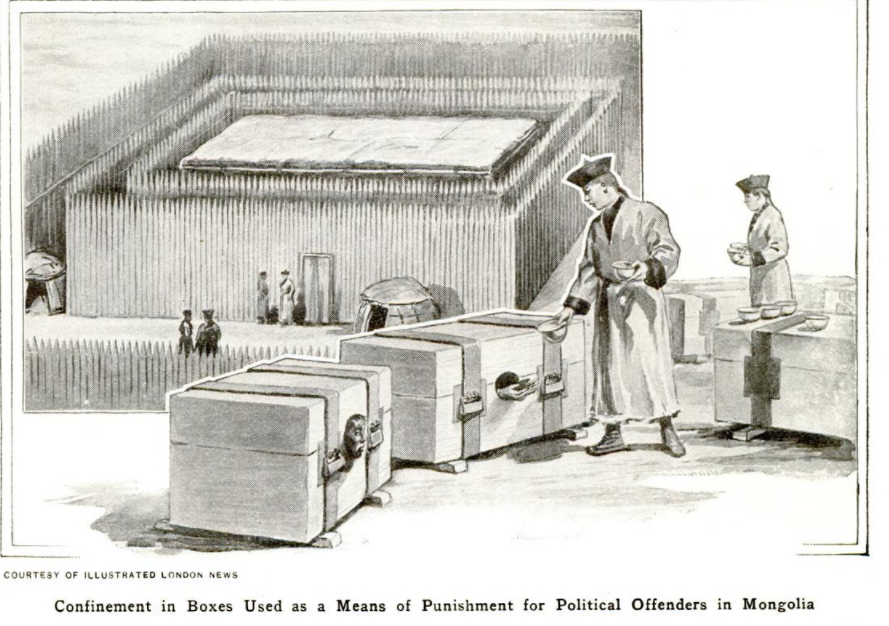
Source of drawing.

Posted By: Paul - Thu Jan 04, 2018 -
Comments (7)
Category: Crime, Death, Dictators, Tyrants and Other Harsh Rulers, Prisons, 1910s, Asia

| Who We Are |
|---|
| Alex Boese Alex is the creator and curator of the Museum of Hoaxes. He's also the author of various weird, non-fiction, science-themed books such as Elephants on Acid and Psychedelic Apes. Paul Di Filippo Paul has been paid to put weird ideas into fictional form for over thirty years, in his career as a noted science fiction writer. He has recently begun blogging on many curious topics with three fellow writers at The Inferior 4+1. Contact Us |




